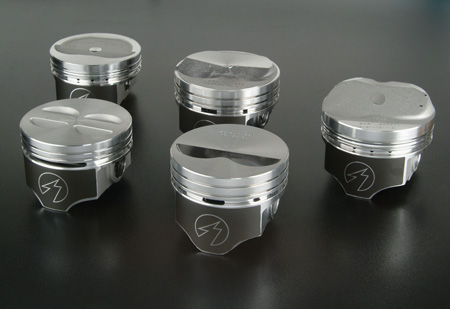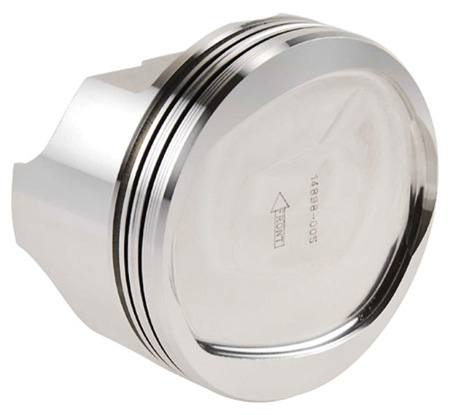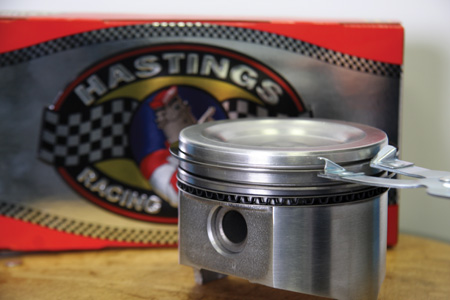The location of the wrist pins must match the stroke of the crankshaft, the length of the connecting rods and the deck height of the block. The compression ratio needs to be right for the application, and the configuration of the piston dome and valve reliefs have to be compatible with the combustion chambers in the cylinder heads, the size of the valves, and the lift and duration of the camshaft.
Other things you need to consider when choosing a set of pistons is the type of material to use. The alloy used in the piston, as well as the manufacturing process, will affect the strength, thermal characteristics and cost of the pistons.
Cast Pistons
Ordinary cast aluminum stock-type OEM or aftermarket pistons are fine for budget rebuilds and even slightly modified engines. But such pistons may not be available in the oversize you want if you’re boring out the block, or the compression ratio you want. The valve reliefs in the tops of the pistons may not be deep enough to provide adequate clearance for larger intake valves, a high lift camshaft or high lift rocker arms.
Your ring choices may also be limited depending on the dimensions of the ring grooves that are available. The location of the wrist pin may also limit what you can do with rod length and stroke if you want to build a stroker motor, and the thickness of the piston crown may limit how much metal can be safely removed to adjust deck height or compression. Finally, stock pistons or cast aftermarket pistons may not be strong enough to handle a significant boost in horsepower.
Hypereutectic Pistons
Hypereutectic pistons are also cast pistons, but are made of a high silicon content alloy. The extra silicon makes them harder, stronger and more wear resistant so they can handle higher loads and temperatures reliably.
The pistons also have a lower coefficient of expansion than most forged alloys, so you can run closer piston-to-cylinder clearances to reduce piston rock and noise. Some hypereutectic pistons are made of 390 alloy and T6 heat treated to improve their strength up to 30 percent over untreated hypereutectic pistons.
Best of all, hypereutectic pistons are an affordable upgrade for many engines, and typically cost 25 to 30 percent less than forged pistons. But for a motor that’s going to make serious horsepower, say anything much beyond 450 to 500 hp, forged pistons are usually a must.
Forged Pistons
Forged pistons are made by stamping a slug of aluminum in a high-pressure die. This usually requires several steps. The forging is then machined to its final dimensions and heat treated to produce the desired strength and hardness characteristics.
The alloys used to create forgings are ductile, which allows them to deform rather than crack or shatter under extreme loads. In a high performance engine, this quality adds a degree of insurance because it can allow the block to survive if the timing chain breaks or the engine sucks a valve. The valve may beat the heck out of the top of the piston, but the piston usually won’t shatter like a hand grenade and spew shrapnel into the crankcase.
The grain structure created by the forging process also improves the strength and heat flow characteristics of the piston. In a high performance engine, this is important because the pistons have to handle much higher combustion temperatures and loads.
The two most commonly used aluminum alloys in forged pistons are 4032 and 2618. Pistons made of 4032 are typically designed for street performance applications, and are also popular with many entry-level drag racers and sportsman circle track racers. It’s a durable alloy that will last more than one season of racing, and will hold up well on the street. It can also handle up to 650 to 700 hp, provided the engine has a good tune and does not go into detonation.
For serious racing, the preferred alloy is usually 2618. This alloy is more malleable than 4032, which allows it to resist detonation better than 4032. It also has a higher coefficient of thermal expansion than 4032, so pistons made of 2618 aluminum require more wall clearance and make more piston noise while a cold engine is warming up. The alloy also tends to degrade more over time than 4032, which means the pistons may have to be replaced after a season of racing.
For a street engine or an engine that has to last several seasons before the owner can afford a rebuild, pistons made of 4032 are usually a better choice.
Piston Designs
Piston weight is another factor that has to match the application. If you’re building a high revving engine, lighter is always better. Lighter pistons reduce the stretching forces on the connecting rods and improve throttle response. Weight is typically reduced by shortening the length of the piston skirt and using a shorter, lighter wrist pin. Of course, the pistons also have to be strong enough to handle higher loads so many use box-type struts inside the piston to reinforce the skirts.
The side profile of the piston is also important so it can handle the heat. The top of the piston is exposed to the heat of combustion, so the upper area of the piston that undergoes the greatest thermal expansion. Tapering the side profile of the piston in slightly toward the top compensates for the increased thermal expansion while allowing tighter wall clearances without scuffing.
The location of the rings on the piston is also a factor to consider. Moving the ring pack higher up on the piston improves sealing and reduces the “crevice volume” that can trap unburned fuel and air. Many OEM pistons use this design feature to reduce emissions. But in a performance engine, a higher ring location also exposes the top ring to more heat, and increases the risk of micro-welding of the ring to the piston land or cylinder wall. To help counter these effects, piston manufacturers may use phosphate coatings or hard anodize the upper ring grooves to reduce micro-welding.
Piston Coatings
A plateau finished cylinder bore with the right crosshatch angle and depth should retain enough oil to prevent piston scuffing – unless the engine overheats, experiences detonation or preignition or something happens in the lubrication system that causes a loss of oil pressure. Dry starts are another common cause of piston scuffing and damage.
One way to help protect the pistons against scuffing is to use pistons that have some type of anti-scuff coating on the side skirts. Moly-graphite is a commonly used material for this purpose. Many piston suppliers offer pre-coated pistons in their product lines, but it can add up to $100 or more to the cost of a set of eight pistons. The other option is to buy uncoated pistons and have them coated by an aftermarket company that specializes in such services. Either way, it will cost you.
Coatings are typically quite thin, and can usually be ignored when figuring piston-to-wall installation clearances unless the piston manufacturer tells you otherwise. Some coatings, though, are thicker and provide a “cushioning effect” that helps reduce piston rock that causes piston noise in a cold engine.
Some coatings are designed to prevent piston scuffing when the engine is first started, and wear away quickly. Other coatings are more long-lived, and should last as long as the pistons (as much as 200,000 miles on typical OEM applications).
Piston Rings
Popular ring sizes today include 1.5 mm, 1.2 mm and 1.1 mm (.043?) top rings with 3.0 mm or even 2.0 mm 3-piece oil rings. Some ring manufacturers even make 1.0 mm one-piece oil rings for some racing applications. Napier-style 2nd compression rings appear to be the most popular style today because they help scrape oil off the cylinder walls to improve oil control.
Cast iron rings are too brittle for high performance, high heat applications so ductile iron or steel rings are usually a must. Plasma-moly or black nitride coatings are the most popular surface treatments for rings. Those who prefer nitrided steel rings say they hold up better in really high heat applications better than anything else.
One ring manufacturer we interviewed told us his company recently introduced a new product line of all steel gas-nitrided rings for high horsepower, high rpm racing engines including nitrous-injected and alcohol blown engines. The 1st and 2nd compression rings are nitrided stainless steel, and the oil ring also has nitrided stainless steel rails and an expander. All the rings also have a physical vapor deposition (PVD) coating of chromium nitride (CrN) on the face to reduce friction and wear. The coating is compatible with all engines, including nicklel/carbide hardened cylinder blocks and liners.
One thing to keep in mind with nitrided rings is that they may take longer to seat in, and they can be harder to file when adjusting ring end gaps than cast iron rings.
Unless you are using “gapless” compression rings, the top ring end gaps usually need to be opened up a bit over stock dimensions to accommodate increased thermal expansion from higher combustion temperatures. The higher the location of the top ring on the piston, the more end gap it usually needs to handle the heat.
Ring tension is another subject that generates a lot of discussion. Thinner, low-tension rings reduce friction and are more conformable, so they can potentially add a little extra horsepower. The downside is they are also more expensive, and require pistons with shallower, narrower ring grooves. One piston manufacturer told us they use “medium” tension rings with their pistons, with about 15 lbs. on the oil rings. Another piston manufacturer said they recommend 12 to 15 lb. oil rings for racing, but like to see a little more ring tension in street applications – say 18 to 22 lbs. – for the oil rings.
Pistons with vertical or lateral gas vents are available to help improve ring sealing, too. The vents route combustion pressure against the ring to help seal it against the piston land and cylinder. Pistons with gas vents are primarily for high rpm racing engines, and should not be used on the street, because carbon buildup from idling can clog up the ports and cause uneven ring sealing.
There’s An App For That
In researching this article, we asked piston suppliers for their recommendations as to which type of pistons would be the best choice for street, strip or circle track engines. For street and budget racing applications, many suppliers have entry level performance pistons, hypereutectic pistons or forged 4032 alloy pistons available in standard or lightweight configurations.
Most said the compression ratio should be limited to 10:1 for most street applications so the engine will run safely on 93 octane premium pump gas. If the engine will be boosted with nitrous oxide, or a turbocharger or supercharger, less compression may be required to prevent detonation.
A really wild cam with a lot of duration will effectively lower the static compression ratio because of the extended valve overlap, so you might be able to run pistons that deliver a little more compression. But wild cams that produce a loping idle are not good for low end torque. They make all their power at higher rpm, and are better suited to the strip or circle track.
For circle track racing, rules often dictate what you can and can’t use. Rules may prohibit the use of domed pistons or high compression ratios. Most circle track racers want light pistons that give good throttle response, so lightweight forged pistons are usually the best choice for this type of application. If the engine will be rebuilt after a season, 2618 alloy pistons can provide an extra margin of engine protection. Otherwise, 4032 will work just fine.
For drag racing, compression ratios of 14:1 to as much as 16:1 are common today. This requires a good tune to prevent detonation, and 2618 forged pistons to handle the heat if you’re going much over 650 to 700 hp.
On drag engines that use power-adders such as nitrous or a blower, the piston skirts also need to be stronger to prevent the pistons from collapsing. Some piston manufacturers use box-style reinforcing ribs to beef up their pistons. Pistons with thicker crowns may also be recommended to handle the increased pressure.
Really high output drag engines also need stronger thick-wall wrist pins to handle the loads. The wrist pins are often starved for oil, so a hard coating on the pins such as physical vapor deposition diamond can help the pins survive.
The best advice we can give you is to talk to your piston supplier about the engine you are building, and ask for its recommendations as to which type of piston will work best in that application. If they don’t have a piston on the shelf that can satisfy your requirements, most suppliers can also fabricate custom pistons to your exact specifications. Custom pistons will cost you, but they may also give you an extra edge over the competition – and that’s what wins races.
For a list of more manufacturers, check out our Buyers Guide.















